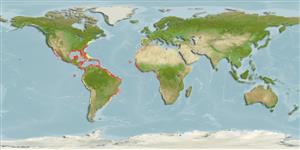Common names from other countries
分類 / Names
共通名の | 類義語 | Catalog of Fishes(部類, 種) | ITIS | CoL | WoRMS | Cloffa
板鰓亜鋼(サメとエイ類) (sharks and rays) >
Orectolobiformes (Carpet sharks) >
Ginglymostomatidae (Nurse sharks)
Etymology: Ginglymostoma: ginglymus (Gr.), hinge; stoma (Gr.), mouth, presumably referring to how corner of mouth has a hinged appearance. (See ETYFish); cirratum: Latin for having tendrils, referring to elongated nasal barbels. (See ETYFish).
More on author: Bonnaterre.
Environment: milieu / climate zone / depth range / distribution range
生態学
海; 汽水性の 関連する礁; 深さの範囲 0 - 130 m (Ref. 43278), usually 1 - 35 m (Ref. 40849). Subtropical; 44°N - 35°S, 122°W - 10°E (Ref. 247)
East Atlantic Ocean: from Cape Verde to Gabon, accidental in France (Ref. 127434).
Length at first maturity / サイズ / 重さ / 年齢
Maturity: Lm 235.0, range 230 - 240 cm
Max length : 430 cm TL オス/雌雄の選別がない; (Ref. 96339); common length : 304 cm TL オス/雌雄の選別がない; (Ref. 247); 最大公表体重: 109.6 kg (Ref. 40637); 最大記録サイズ: 25 年 (Ref. 72467)
簡単な記述
検索表 | 形態学 | 形態計測学
背面の脊椎 (合計) : 0. Moderately long barbels, nasoral grooves present but no perinasal grooves, mouth well in front of eyes, spiracles minute, precaudal tail shorter than head and body, dorsal fins broadly rounded (the first much larger than the second and anal fins), caudal fin moderately long, over 1/4 of total length, yellow-brown to grey-brown in color, with or without small dark spots and obscure dorsal saddle markings (Ref. 247). Head blunt, mouth inferior, pair of conspicuous barbels between nostrils (Ref. 26938).
Found on continental and insular shelves. Solitary (Ref. 26340) and sluggish fish, often encountered lying on the bottom (Ref. 9987). Nocturnal, feeding on bottom invertebrates such as spiny lobsters, shrimps, crabs, sea urchins, squids, octopi, snails and bivalves, and fishes like catfishes, mullets, puffers and stingrays. Ovoviviparous with 21 to 28 young in a litter (Ref. 9987, 43278). Kept in captivity for researches. May attack humans if they are molested or stepped upon accidentally. Edible, but mainly valued for its hide, which makes extremely tough and durable leather (Ref. 9987). Common over shallow sand flats, in channels, and around coral reefs; young may be found among prop roots of red mangroves (Ref. 26938).
Ovoviviparous, with 21 to 28 young in a litter. Development of young in the uterus being sustained by a large supply of yolk. Females give birth in late spring and summer in waters off Florida. During courtship, a pair sometimes a triplet of adults engaged in synchronized parallel swimming. While on it, the male may grab one of the female's pectoral fins with his mouth which induces the female to pivot 90° and roll on her back on the bottom. Then the male inserts a clasper in her vent, and then roll on his back beside the female. Pair may break apart and depart rapidly after copulation or the male may remain motionless on the subtrate as if recovering from the mating bout (Ref. 49562). Not all attempts of males to copulate with a female nurse shark result in successful fertilization, females may employ avoidance by 'pivotting and rolling' to escape from male attention (Ref. 49562). Or females may 'lie on back' and rest motionless and rigidly on the substrate (Ref. 51113, 49562). On the contrary, females send signals of readiness to copulate with males by arching their body toward their male partner and cupping the pelvic fin (Ref. 51126, 49562). Male nurse sharks may mate with many females over several weeks (polygyny) and vice versa (polyandry) (Ref. 49562). Also Ref. 205.
Compagno, L.J.V., 1984. FAO Species Catalogue. Vol. 4. Sharks of the world. An annotated and illustrated catalogue of shark species known to date. Part 1 - Hexanchiformes to Lamniformes. FAO Fish. Synop. 125(4/1):1-249. Rome, FAO. (Ref. 247)
CITES (Ref. 128078)
Not Evaluated
人間に対する脅威
Traumatogenic (Ref. 4690)
Human uses
水産業: 少数商業の; 水族館・水槽: 公共の水族館
用具
特記事項
XMLをダウンロードして下さい
インターネットの情報源
Estimates based on models
Preferred temperature (Ref.
115969): 22.3 - 28, mean 25.5 (based on 798 cells).
Phylogenetic diversity index (Ref.
82804): PD
50 = 0.8125 [Uniqueness, from 0.5 = low to 2.0 = high].
Bayesian length-weight: a=0.00417 (0.00157 - 0.01110), b=3.08 (2.85 - 3.31), in cm Total Length, based on LWR estimates for this (Sub)family-body shape (Ref.
93245).
栄養段階 (Ref.
69278): 4.2 ±0.2 se; based on diet studies.
回復力 (Ref.
120179): 低い, 4.5年~14年の倍増期間の最小個体群 (K=0.14; tmax=25; Fec=21-28).
Fishing Vulnerability (Ref.
59153): Very high vulnerability (90 of 100).
Climate Vulnerability (Ref.
125649): High vulnerability (65 of 100).
